
Nipple piercings are not quick or easy to heal in general. So if you have a history of surgical procedure(s) in the area, (or scarring from previous piercing) it is especially critical to be throughly evaluated by a qualified and ethical professional prior to piercing.
Depending on the location and extent of scarring, piercing may not be appropriate.
General Information
It is important to be sure you're thoroughly healed following a localized surgery before seeking a piercing in the region. It is prudent to wait at least a year, and possibly two, for the tissue to fully normalize before piercing.
It is also vital to be carefully evaluated before repiercing a nipple that is scarred from a problematic prior piercing--especially if there was significant migration or rejection.
If you have scar tissue directly at the site where the jewelry should go, this might make piercing inadvisable. Consult with a professional piercer to examine the area and discuss any specific considerations and concerns with you.
It is critical that the skin is pliable. If your scarring is so pronounced that the tissue (where the piercing belongs) is hard, dense, and inflexible, the piercing is apt to be much harder--or maybe even impossible--to perform, or to heal. Migration and rejection are far more likely when the tissue is not pliable.
It is not normally problematic for individuals who have undergone breast reduction or augmentation surgery to receive nipple piercings. The areolar scarring that results from such procedures is not usually located where a piercing would be placed, and is therefore seldom prohibitive. If healing from surgery was troubled and unusual scarring remains, that could potentially be an issue.
If you have implants, use sound judgment when selecting a piercer and strictly comply with all post-piercing guidelines. The risks are more serious: an infection from a nipple piercing can spread to your implant, possibly require surgical intervention, and potentially result in the loss of your augmentation.
Those who have experienced diminished sensation from breast surgery often report positive results from nipple piercing!
A surgical procedure that can make nipple piercing impractical or unsafe is when the nipple tip is trimmed down, as is commonly done in FTM (female-to-male) chest surgeries.
Also, if you have undergone radical breast surgery and reconstruction with nipple replacement using non-areolar tissue, you are generally not a good candidate. Piercing might be possible if the donor tissue is a type that heals easily, such as from the labia minora. An expert piercer and your surgeon should both be consulted before proceeding. The two-year wait time would be advisable in these cases.
Want to get pierced by Elayne Angel?
Placement
The piercing should be positioned at the base of the nipple, right at the natural groove or crease where the nipple tip rises from the areola. This is the case unless the nipple is too small (measuring less than 3/8" from entry to exit, on tissue that is not "tall" or pronounced). If the nipple is too small, then the piercing belongs in the next natural crease back to ensure there is sufficient tissue for a viable piercing. If piercings are too superficial, there is a tendency for the body to perceive and treat them like foreign objects, so migration and rejection are more likely.
If scarring makes horizontal placement inadvisable, the tissue can be evaluated for an alternative angle that might work better with the local considerations.
On nipples that have been pierced before, sometimes they can be redone in the same position. This is most desirable if the piercings were properly placed initially. If the original placement was not optimal, then it is best to adjust the position to a more preferred location.
Below is are images of two different scarred nipples that were marked with an alternative (angled/non-horizontal) placements to avoid the scar tissue as much as possible, and to frame the region nicely, with the dots placed at the natural crease on each side. Following rejection, it is generally inadvisable to attempt repiercing at the same angle, due to the inherent weakness of scar tissue.
Also below is a set of nipple piercings on a woman who had a breast reduction and lift. The piercings were angled to mirror the unique, elliptical shape of her areolas. When her nipples are relaxed, there is only a small amount of extra room on the bar.
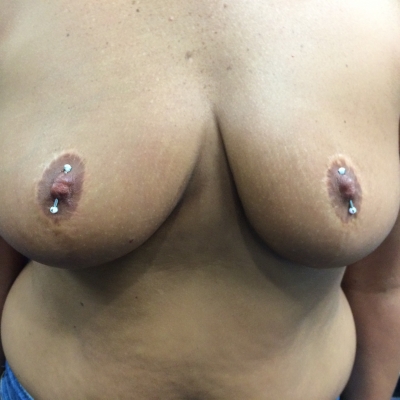

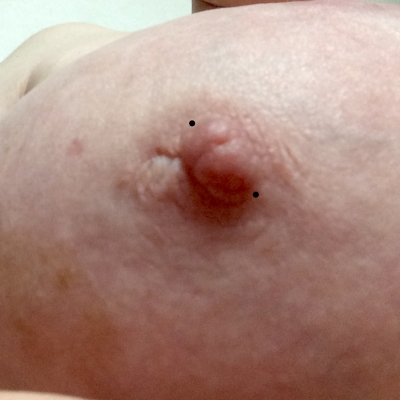
Jewelry
Barbells are easier for healing in all nipple piercings, and they should definitely be worn in non-horizontal placements.
A small amount of extra room on each side of the post is desirable for initial jewelry. A barbell in a fresh or healing nipple piercing should not pinch or sink into the nipple at all. You should be able to view each ball as a full sphere when round ends are worn.
The ball size on barbells must be moderated to suit the anatomy. On smaller and flatter nipples, it is critical to have smaller balls, in the range of 3-4mm or 5/32"-3/16". This helps to prevent the jewelry from being forced away from the body and lead to migration, which can happen with larger balls.
Rings tend to cause more trauma and irritation than bars. Also, a ring that fits properly must be large enough so that the part that passes through the tissue is relatively straight. The ring should take up no more than a third of the ring diameter, and one quarter would be even safer.
This requires rings that are significantly wider in diameter than most piercees expect to wear, and larger than many piercers actually use. That is, I see piercers commonly inserting rings that are too small, which causes migration, discomfort, and other complications.
Below, a photo shows the damage caused to a fresh nipple piercing by a ring that is far too small.
The other image shows an appropriate fit for a barbell (with a little extra room) on a female nipple. This is a good fit ONLY if the tissue does not relax and widen out when the nipple is not erect!
This is an area in which many piercers make jewelry sizing errors--putting in jewelry that fits properly for the erect size, without evaluating the nipple at its widest resting state. This can be very painful and result in serious complications including migration, scar tissue formation, and even embedded jewelry. Some nipples double in width between erect and relaxed states! This piercee has a nipple that naturally remains erect at all times, so the fit is suitable. Your piercer must size your jewelry to fit your widest, relaxed dimension at the site of the piercing, which can be done by spreading the tissue manually.
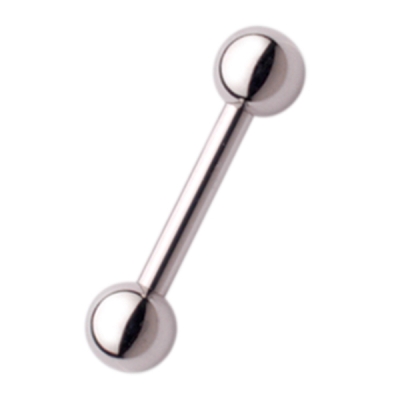
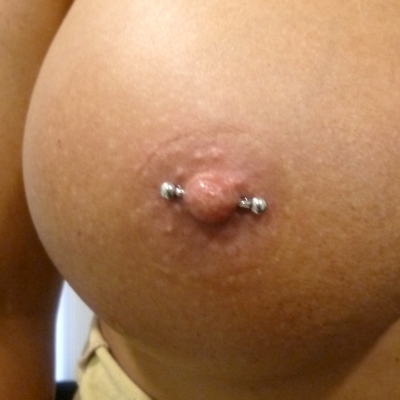
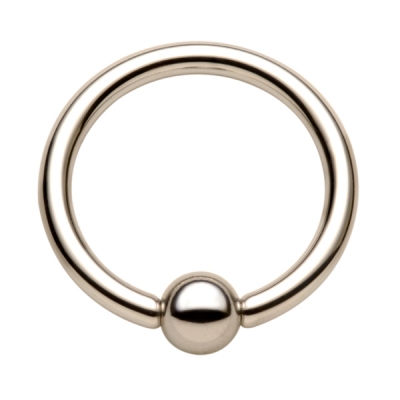
Procedure
I normally use forceps for nipple piercing procedures. An exception would be made if the scar tissue prevents the clamp from being placed safely and securely to facilitate the piercing. On these occasions, I will do nipple piercings freehand (without any forceps), if that is the safest option, or the only way to achieve the desired placement.
On nipples that have scar tissue, additional "tissue manipulation" may be necessary and helpful to prepare the area for piercing. Especially when the nipple is hard and dense, rolling and pinching the tissue (in the shape and direction of the piercing) can help to make the process easier for both piercer and piercee. I've pierced nipples that were too tight and inflexible to apply the forceps, but after a brief period of manipulation, the procedure was able to successfully be accomplished.
Learn which piercing(s) you are built for?
Healing and Troubleshooting
Nipple piercings take time and patience to heal. This may be especially true if the area has reduced circulation due to the presence of scar tissue. So it is critical that piercees with a history of surgical procedures in the region take especially good care of their piercings.
In these cases, I highly suggest twice daily saline soaks (not just spray), along with regular care.
It is good to know that nipple piercings normally have a healing course that includes series of "ups and downs." This means that the piercings tend to go through phases of seeming "fine" and possibly even healed, and then, without a change in your behavior or habits, it will suddenly seem no longer fine, and may become irritated, swollen, or otherwise act up. This is perfectly normal.
The best thing to do is remain consistent with care and each your lifestyle habits.
If you think you are not eating a sufficiently nutritious, balanced diet, you may want to take a multivitamin-mineral supplement (or at least make sure you’re getting some C and zinc, and B vitamins).
Also, are you drinking enough water? Managing stress? Sleeping enough? Poor health habits can impact healing.
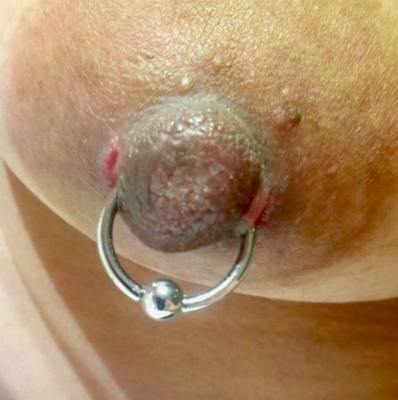
What My Happy Clients Say
Going to Elayne was an incredible experience. She is wonderfully gifted & gracious expert.
There was NO pain from the extremely quick & perfectly placed piercings.
My words of praise seem too menial when compared with the professionalism, passion and empathy she has for what she does.
There is no one like you! Thank you Elayne! You ROCK!
How amazing it was to be pierced by this fantastic woman!
It took no time at all for Elayne to mark and prep me. When the actual piercing time came Elayne had both in so quickly I was mostly just stunned instead of in excruciating pain.
Anyone thinking of being pierced by Elayne should do it! I will certainly be back!
I was lucky enough to have my nipples pierced by Elayne and I couldn't be happier with how they turned out!
The actual piercing was so fast that I barely had a chance to realize it happened!
If you're debating whether or not it's worth the price and wait to be pierced by Elayne, it is. It's really as simple as that!
